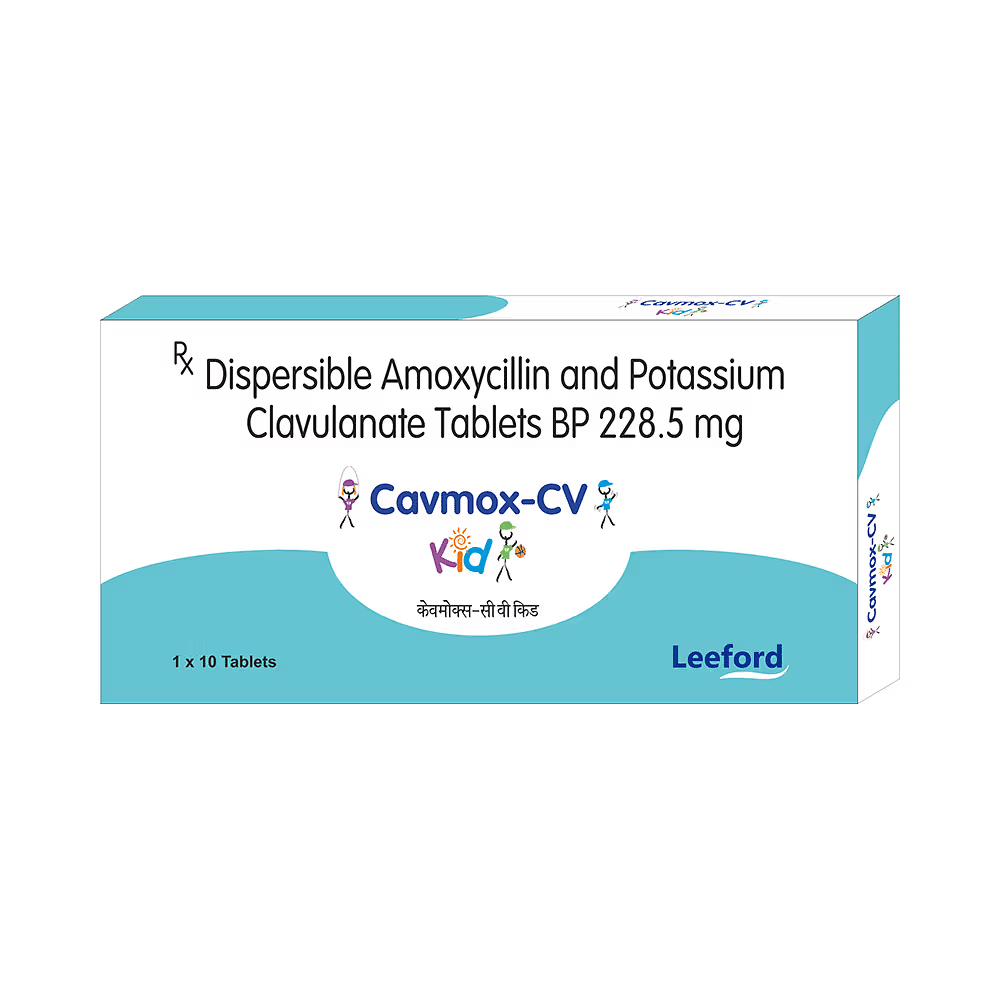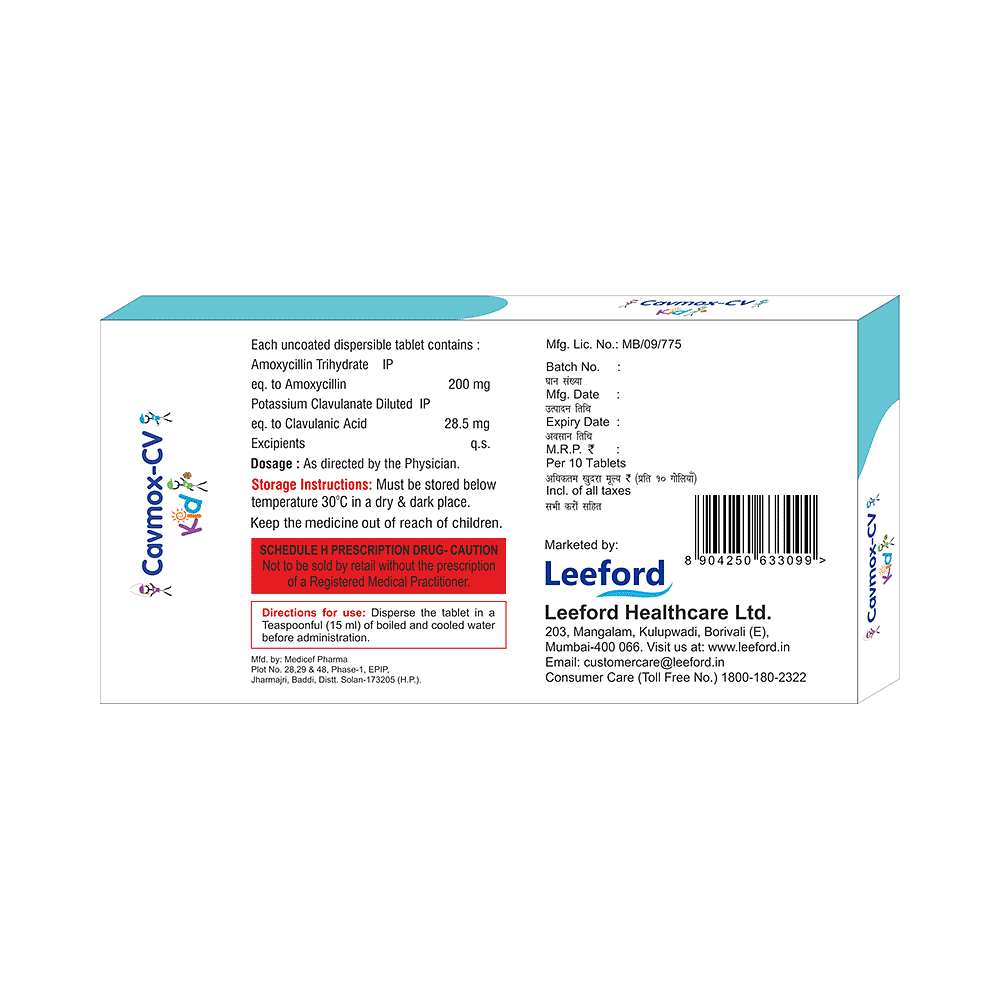

Cavmox-CV Kid Tablet
Manufacturer
Leeford Healthcare Ltd
Salt Composition
Amoxycillin (200mg) + Clavulanic Acid (28.5mg)
Key Information
Short Description
Cavmox-CV Kid Tablet is an antibiotic medicine that helps treat bacterial infections of the ear, nose, throat, chest, lungs, teeth, skin, and urinary tract.
Dosage Form
Tablet
Introduction
Cavmox-CV Kid Tablet is an antibiotic medicine that helps treat bacterial infections of the ear, nose, throat, chest, lungs, teeth, skin, and urinary tract. It is capable of killing bacteria that have become resistant to other therapies and thus also helps treat tuberculosis that is resistant to other treatments. You can give Cavmox-CV Kid Tablet to your child with or without food. It is better to give it with food as that helps increase absorption and decrease the risk of stomach upset. The doctor may prescribe giving it two to three times a day. Medicine dose depends on the severity of the infection, its type, and your child’s body weight and age. So, stick to the dose, time, and way prescribed. If your child vomits the medicine within 30 minutes of intake, let the child calm down and repeat the dose. Do not double dose if it's the time for the next dose.
Directions for Use
Take this medicine in the dose and duration as advised by your doctor. Swallow it as a whole. Do not chew, crush or break it. Cavmox-CV Kid Tablet is to be taken with food.
Safety Information
Side Effects
No common side effects listed
Alcohol Warning
It is not known whether it is safe to consume alcohol with Cavmox-CV Kid Tablet. Please consult your doctor.
Breastfeeding Warning
Cavmox-CV Kid Tablet is safe to use during breastfeeding. Human studies suggest that the drug does not pass into the breastmilk in a significant amount and is not harmful to the baby.
Pregnancy Warning
Cavmox-CV Kid Tablet is generally considered safe to use during pregnancy. Animal studies have shown low or no adverse effects to the developing baby; however, there are limited human studies.
How it works
Cavmox-CV Kid Tablet is an antibiotic. It has two active agents, amoxycillin and clavulanic acid. Amoxycillin works by preventing the formation of the bacterial protective covering (cell wall) essential for the survival of the bacteria. Whereas, clavulanic acid serves a special purpose of inhibiting an enzyme (beta-lactamase) that is produced by resistant bacteria. This makes the combination of amoxycillin and clavulanic acid an effective line of treatment for many types of infections.
Quick Tips
Your child must complete the entire course of antibiotics. Stopping too soon may cause the bacteria to multiply again or cause another infection. Your child may have a bitter taste in the mouth after the intake of Cavmox-CV Kid Tablet. Eating citrus fruit or sipping plenty of water or fruit juice may help. Encourage your child to drink plenty of water in case diarrhea develops as a side effect. Never give Cavmox-CV Kid Tablet until and unless prescribed by the doctor. You must also never share your child’s medicine with anyone else even if they show similar symptoms. Do not give Cavmox-CV Kid Tablet to treat common cold and flu-like symptoms caused by viruses. Never save medicine for future illnesses. It cannot be said whether the same medicine will work on future infections. Check ‘expiry’ before giving Cavmox-CV Kid Tablet to your child. Immediately discard all the expired medicines. Stop Cavmox-CV Kid Tablet immediately if your child develops an itchy rash, facial swelling, or breathing difficulty. Report to the doctor without any delay.
Related Medicines

Moxikind CV Kid Tablet

Neomax Kid 200mg/28.5mg Tablet

Amexosyn Kid 200mg/28.5mg Tablet

Moxifed CV Kid 200mg/28.5mg Tablet

Comoclav Kid 200mg/28.5mg Tablet

Exclusive 200 mg/28.5 mg Tablet

Lactaclav 200mg/28.5mg Tablet

Fanclav Kid 200mg/28.5mg Tablet

Penalin CV 200 mg/28.5 mg Tablet

Moxileb CV 200 mg/28.5 mg Tablet
Frequently asked questions
Can other medicines be given at the same time as Cavmox-CV Kid Tablet?
Cavmox-CV Kid Tablet may interact with other medications. It's crucial to inform your child's doctor about all medications they are currently taking before starting Cavmox-CV Kid Tablet, and always consult with a healthcare professional before administering any medication to your child.
Can I get my child vaccinated while on treatment with Cavmox-CV Kid Tablet?
Antibiotics usually do not interfere with vaccine ingredients or cause reactions in children after vaccination. However, it's best to avoid vaccinating until the child has recovered from any illness they may have. Once your child feels better, the vaccine can be administered.
Which lab tests may my child undergo while taking Cavmox-CV Kid Tablet on a long-term basis?
Periodically, during extended therapy, doctors may monitor kidney and liver function to assess your child's condition.
Can I give a higher than the recommended dose of Cavmox-CV Kid Tablet to my child?
Do not exceed the recommended dosage of this medication as doing so may increase the risk of side effects. If your child experiences worsening symptoms, consult their doctor for re-evaluation.
Can I stop giving Cavmox-CV Kid Tablet to my child when the symptoms are relieved?
Do not discontinue this medication unless you have consulted with your child's doctor and completed the full course of treatment, even if you feel better. Symptoms may improve before the infection is fully cleared. Continue taking the medication as prescribed.
Can the use of Cavmox-CV Kid Tablet cause diarrhea?
Yes, Cavmox-CV Kid Tablet can cause diarrhea, as it's an antibiotic that kills harmful bacteria and may affect beneficial bacteria in the stomach. Encourage your child to drink plenty of fluids if they experience diarrhea. If diarrhea persists, talk to your doctor about potential dehydration symptoms (such as decreased urination or dark/strong-smelling urine), and consult for guidance before administering any other medication.
Do all viral common colds result in secondary bacterial infection?
Most viral infections do not lead to secondary bacterial infection. In fact, giving antibiotics to a viral infection can increase the risk of side effects. Consulting your child's doctor is crucial for proper treatment.
The mucus coming out of my child’s nose is yellow-green. Is it a sign of a bacterial infection?
Yellow or green mucus in the nose does not automatically indicate a need for antibiotics. During a typical cold, the mucus thickens and changes color from clear to yellow or green. Symptoms usually last 7-10 days.
Is there any sign which shows that my child needs immediate medical attention?
Seek immediate medical attention for your child if they experience serious allergic reactions (breathing problems, skin rashes), gastrointestinal infections (diarrhea), or liver damage (weakness, paleness, vomiting). While rare, these side effects are critical and require a healthcare professional's intervention.


